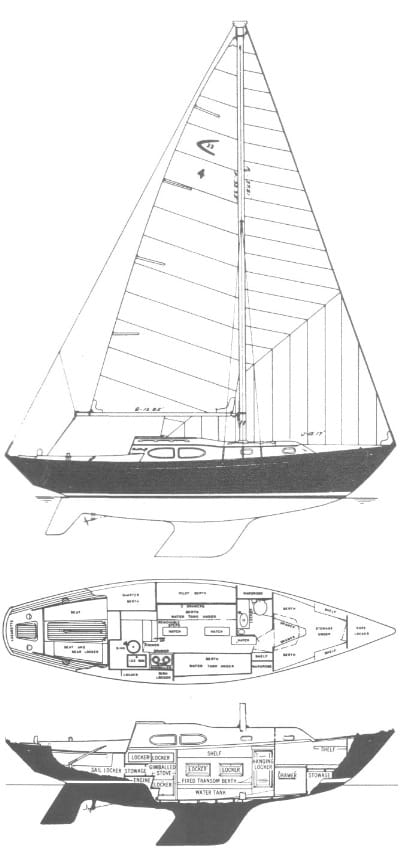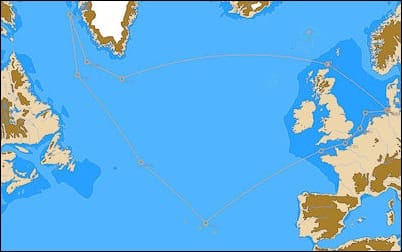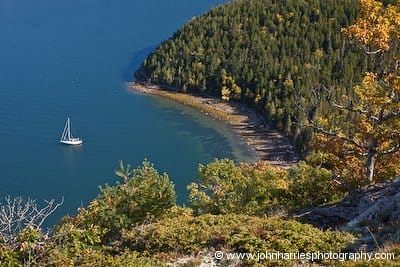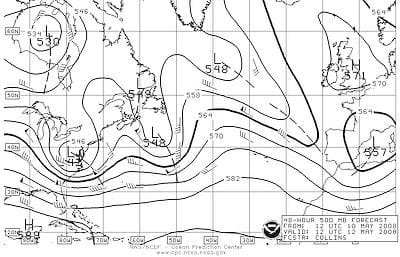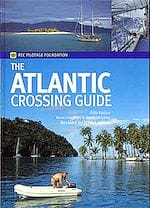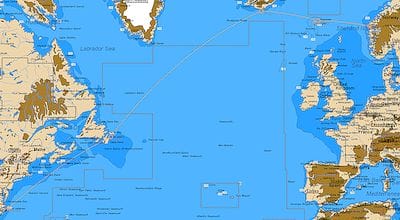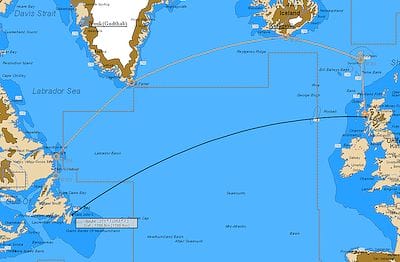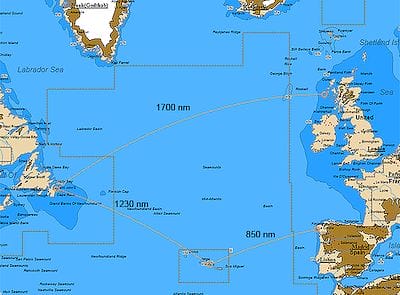Passage Planning
Child Topics:
Click for TOC or scroll down for details
Articles in this topic:
- Trans-Atlantic Single-Handed Sanity Check
- Racing To Cruise
- Q&A: Crossing The Atlantic In A 32-foot Boat
- Q&A: A Late West To East Atlantic Crossing
- Q&A: A Novel, But Probably Smart, Way To Cross The Atlantic, East To West
- Q&A: Trans-Ocean Navigation
- Q&A: Trans-Atlantic In An Old Boat
- Coastal Overnights—They’re Tough But They Get The Job Done
- Q&A: Risk Management, Hurricanes
- The Gulfstream, Everything You Wanted To Know
- Q&A: Picking A Weather Window For A West To East Atlantic Crossing
- Q&A: Picking A Sailing Route Across The North Atlantic, West To East
- Q&A: Best Time For A West To East Atlantic Crossing
- Q&A: Timing, Caribbean To Europe
- Q&A: Norway To The Chesapeake Bay
- Q&A: North Atlantic Crossing, East To West, In Fall
- Q&A: Autumn Crossing Of The North Atlantic, West To East
- Q&A: Sailing From Halifax To Bermuda In November
- Q&A: Trans-Atlantic Singlehanded
- Q&A: Newfoundland To Europe Via The Azores In June
- Q&A: Maine To Ireland In June
- Q&A: BVI To The Chesapeake Bay In October
- Q&A: France To Tortola In The Autumn
- Q&A: UK To Boston Via The North In June
- Q&A: North Atlantic Circle Via Iceland
-
Trans-Atlantic Single-Handed Sanity Check
83 CommentsReading Time: 2 minutesFreeRead more: Trans-Atlantic Single-Handed Sanity CheckWhat experience do you need to cross the Atlantic safely while single handed on a sailboat?
-
Racing To Cruise
17 CommentsReading Time: 5 minutesFreeRead more: Racing To CruiseRacing sailboats is a great way to gain experience that will be invaluable when we go offshore cruising. John shares a passage across the Gulf of Maine.
-
Q&A: Crossing The Atlantic In A 32-foot Boat
42 CommentsReading Time: 2 minutesFreeRead more: Q&A: Crossing The Atlantic In A 32-foot BoatQuestion: I received a Cris Craft 32′ cruiser/racer as a gift. This is my first boat and I’d like to sail it to France from NYC. I’m preparing it for solo sailing and would like your opinion on it’s survivability. A Sparkman& Stephens design…it has a fin keel and a lovely interior. It has been […]
-
Q&A: A Late West To East Atlantic Crossing
10 CommentsReading Time: 3 minutesFreeRead more: Q&A: A Late West To East Atlantic CrossingQuestion: I am a fairly experienced Swedish sailor; however, I have never “crossed the pond”. We have decided to buy a MacGregor 65. There are several for sale at good prices in the US, but very few in Europe. We will miss the most appropriate season [to cross the Atlantic]. Hence, I want to ask […]
-
Q&A: A Novel, But Probably Smart, Way To Cross The Atlantic, East To West
2 CommentsReading Time: 3 minutesFreeRead more: Q&A: A Novel, But Probably Smart, Way To Cross The Atlantic, East To WestQuestion: I’m thinking about sailing to Greenland from my home in Germany. My boat is a very sound 33-foot steel sloop, which I have singlehanded often. The natural way to go to Greenland from the German coast seems to be to use the stepping stones: Norway and/or Scotland/Shetlands, thence to Faroe and Iceland and on […]
-
Q&A: Trans-Ocean Navigation
8 CommentsReading Time: 2 minutesFreeRead more: Q&A: Trans-Ocean NavigationQuestion: We are crossing the Atlantic from the Canary Islands to St. Lucia. I found a large scale chart of the Atlantic (Imray Passage Chart 100). This single chart shows the entire Atlantic Ocean taking the earth’s curvature into account and therefore does NOT have a compass rose to help steer by. I am having […]
-
Q&A: Trans-Atlantic In An Old Boat
0 CommentsReading Time: 3 minutesFreeRead more: Q&A: Trans-Atlantic In An Old BoatQuestion: I have my 36′ Aage Nielsen yawl in Norway and I need to bring her home to Maine. I would appreciate your comments regarding my choice of routes. One idea is down to the Azores and then over to the eastern US; the reverse of how I sailed to Europe. The other option I’m […]
-
Coastal Overnights—They’re Tough But They Get The Job Done
0 CommentsReading Time: 3 minutesFreeRead more: Coastal Overnights—They’re Tough But They Get The Job DoneAfter spending much of the last four winters in Maine and Nova Scotia refitting Morgan’s Cloud, John and I agreed that a winter in the Bahamas would be just the ticket. So when the blazing fall colours and chilly temperatures of early October indicated that Penobscot Bay, Maine wasn’t going to remain the balmy summer […]
-
Q&A: Risk Management, Hurricanes
2 CommentsReading Time: 2 minutesFreeRead more: Q&A: Risk Management, HurricanesQuestion [received July 11, 2008]: We’re in St. John’s, Newfoundland, waiting to cross to Scotland. We’re just about ready to go and the weather forcast is good for leaving. However, Hurricane Bertha is just south of Bermuda. The current forecast is for her to weaken to 55 knots within four to five days, and stay […]
-
The Gulfstream, Everything You Wanted To Know
0 CommentsReading Time: < 1 minuteFreeRead more: The Gulfstream, Everything You Wanted To KnowA friend of ours, who is a cruise ship captain, sent along the following list of links to everything, and I do mean everything, you have always wanted to know about the Gulf Stream. Some interesting stuff.
-
Q&A: Picking A Weather Window For A West To East Atlantic Crossing
8 CommentsReading Time: 2 minutesFreeRead more: Q&A: Picking A Weather Window For A West To East Atlantic CrossingQuestion: I’m planning an Atlantic Crossing from Boston to Scotland. How can I recognize the best moment weather wise to leave for the safest crossing?
-
Q&A: Picking A Sailing Route Across The North Atlantic, West To East
21 CommentsReading Time: 4 minutesFreeRead more: Q&A: Picking A Sailing Route Across The North Atlantic, West To EastQuestion: We’re planning to sail from New York to Falmouth (UK) leaving around May 18th. Our plan is to sail WSW out from New York till we hit the Gulf Stream and then attempt to sail the great circle to Falmouth. We’re debating whether to consider a more southerly route to stay clear of weather […]
-
Q&A: Best Time For A West To East Atlantic Crossing
0 CommentsReading Time: < 1 minuteFreeRead more: Q&A: Best Time For A West To East Atlantic CrossingQuestion: I will be sailing to Gibraltar from the Chesapeake via the Azores. When would be the best time to leave and when would be the earliest I could/should leave?
-
Q&A: Timing, Caribbean To Europe
0 CommentsReading Time: < 1 minuteFreeRead more: Q&A: Timing, Caribbean To EuropeQuestion: What is the best time of year to sail from the Caribbean to Europe?
-
Q&A: Norway To The Chesapeake Bay
0 CommentsReading Time: 3 minutesFreeRead more: Q&A: Norway To The Chesapeake BayQuestion: I’m planning to sail from south Norway in mid-June in my Oceanis 46, hoping to arrive in the Chesapeake Bay by the beginning of August. The crew will be 5 to 6 relatively experienced sailors. Presently I’m looking at routing via Færoe and Iceland, then across to Newfoundland and then coastal. My idea is […]
-
Q&A: North Atlantic Crossing, East To West, In Fall
10 CommentsReading Time: 2 minutesFreeRead more: Q&A: North Atlantic Crossing, East To West, In FallQuestion: I’m planning an east to west crossing via the northern route from the UK to Canada. Ideally I would like to do this in August or September and without stops. My boat is a Hallberg Rassy 46. What do you think?
-
Q&A: Autumn Crossing Of The North Atlantic, West To East
0 CommentsReading Time: 3 minutesFreeRead more: Q&A: Autumn Crossing Of The North Atlantic, West To EastQuestion: I am planning a west to east North Atlantic crossing and have read that most yachts leave in May and June. What about leaving in mid-September or early October? Is that still a possibility? Ideally I would like to cross from St. John’s, Newfoundland to Britain.
-
Q&A: Sailing From Halifax To Bermuda In November
9 CommentsReading Time: 2 minutesFreeRead more: Q&A: Sailing From Halifax To Bermuda In NovemberQuestion: I just brought my 34-foot sailboat down the Saint Lawrence to Nova Scotia, and I’m considering making the passage to Bermuda in November and then continuing further south for the winter. I’ve been hearing all kinds of differing opinions about the safety of heading out from Halifax in November, and I thought you could […]
-
Q&A: Trans-Atlantic Singlehanded
0 CommentsReading Time: 2 minutesFreeRead more: Q&A: Trans-Atlantic SinglehandedQuestion: I’m at a point in my life when it’s time to live the dream that I’ve had since childhood and that’s to sail across the Atlantic single handed. I’m a complete beginner to sailing. I’m currently doing a skipper’s course which will take me up to advanced cruising, coastal navigation and radio operation, although […]
-
Q&A: Newfoundland To Europe Via The Azores In June
4 CommentsReading Time: 2 minutesFreeRead more: Q&A: Newfoundland To Europe Via The Azores In JuneQuestion: We would like to seek your advice on my next summer’s trip from Newfoundland to the Azores, then on to Europe. We left our boat in Newfoundland last year and plan to leave for Europe in June to avoid the hurricane season.
-
Q&A: Maine To Ireland In June
17 CommentsReading Time: 2 minutesFreeRead more: Q&A: Maine To Ireland In JuneQuestion: I am a 46 year old professional in fairly good health and in good shape. I am wanting to reverse the steps of my great-great-grandfather, sailing from Belfast, Maine to Bantry Bay, Ireland. I plan to leave June 3rd, 2011. What is my best/safest route? What time frame should I use? I have calculated […]
-
Q&A: BVI To The Chesapeake Bay In October
0 CommentsReading Time: < 1 minuteFreeRead more: Q&A: BVI To The Chesapeake Bay In OctoberQuestion: We are bringing our Beneteau 411 from the BVI via the Bahamas to the Chesapeake Bay, leaving the end of October. The first leg of the trip, from the BVI to the Bahamas, is going to be the two of us (my husband and I). From the Bahamas to the Chesapeake Bay we will […]
-
Q&A: France To Tortola In The Autumn
2 CommentsReading Time: < 1 minuteFreeRead more: Q&A: France To Tortola In The AutumnQuestion: I have an opportunity to sail from France to the Canaries to Tortola, leaving the end of September through October. What can I expect from a weather perspective based on your experience? My assumption is we will be in the area of hurricane formation (eastern Atlantic) for the first week then right in the […]
-
Q&A: UK To Boston Via The North In June
4 CommentsReading Time: 2 minutesFreeRead more: Q&A: UK To Boston Via The North In JuneQuestion: I wondered if I could seek your advice on a trip that has been suggested to me but that I have serious reservations about: Sailing from the UK to Boston, leaving around the end of May, taking the North Atlantic route. The skipper seems to be under the impression that we will have easterly […]
-
Q&A: North Atlantic Circle Via Iceland
1 CommentReading Time: < 1 minuteFreeRead more: Q&A: North Atlantic Circle Via IcelandQuestion: Next May we are taking our new (old) boat on a shakedown to Bermuda and back (our home port is Deltaville, VA, on the southern Chesapeake Bay). After that, we’ve been imagining a summer voyage in the Atlantic, maybe Azores-Ireland-Iceland-Canada-Chesapeake. My question is, is there a good route strategy for this trip?



